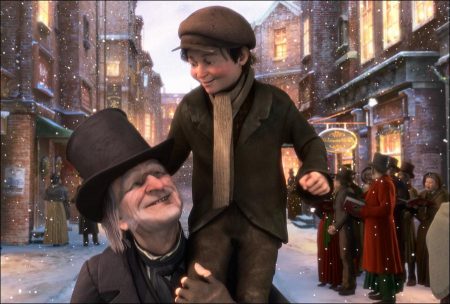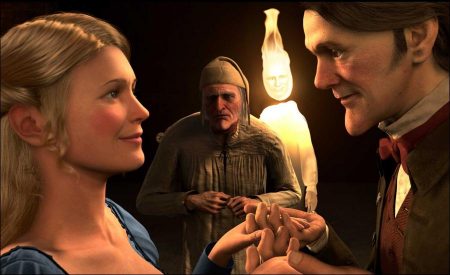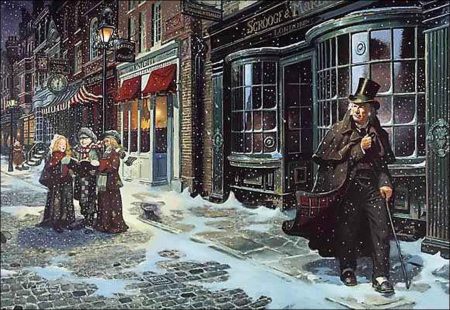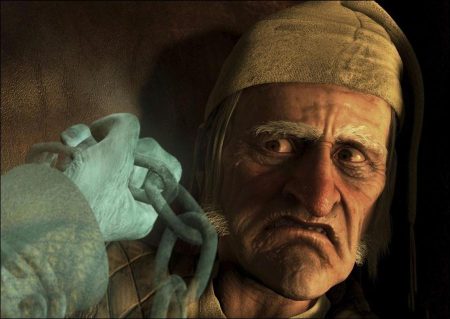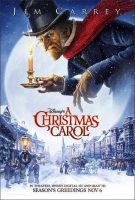Taglines: Christmas comes but once a year, but for one man, that’s once too often.
Disney’s A Christmas Carol, a multi-sensory thrill ride re-envisioned by Academy Award-winning filmmaker Robert Zemeckis, captures the fantastical essence of the classic Dickens tale in a groundbreaking 3-D motion picture event.
Ebenezer Scrooge (Jim Carrey) begins the Christmas holiday with his usual miserly contempt, barking at his faithful clerk (Gary Oldman) and his cheery nephew (Colin Firth). But when the ghosts of Christmas Past, Present and Yet to Come take him on an eye-opening journey revealing truths Old Scrooge is reluctant to face, he must open his heart to undo years of ill will before it’s too late.
Joining Carrey is a diverse group of gifted actors. Gary Oldman (“Harry Potter and the Order of the Phoenix”) stars as Scrooge’s beleaguered employee, Bob Cratchit, his young and ill son Tiny Tim, as well as the ghost of Joseph Marley, Scrooge’s deceased business partner. Colin Firth (“Love Actually,” “The Accidental Husband,” “Bridget Jones: The Edge of Reason”) stars as Fred, Scrooge’s cheerful, good-hearted nephew. Robin Wright Penn (“State of Play”) stars as Belle, who long ago stole Scrooge’s heart, and Fan, Scrooge’s now deceased sister.
“Disney’s A Christmas Carol” will be presented in Disney Digital 3D™, RealD 3D and IMAX® 3D. The film has been rated PG by the MPAA Ratings Board for scary sequences and images. RealD 3D is the new generation of entertainment, with crisp, bright, ultra-realistic images so lifelike you feel like you’ve stepped inside the movie. RealD 3D adds depth that puts you in the thick of the action, whether you’re joining favorite characters in a new world or dodging objects that seem to fly into the theatre. RealD pioneered today’s digital 3D and is the world’s most widely used 3D cinema technology with over 9,000 screens under contract and nearly 4,000 screens installed in 48 countries. And unlike the old days of paper glasses, RealD 3D glasses look like sunglasses, are recyclable and designed to comfortably fit on all moviegoers, and easily over prescription glasses.
Along with the film’s nationwide release in conventional theatres, “Disney’s A Christmas Carol” will be released in IMAX theatres, digitally re-mastered into the unparalleled image and sound quality of The IMAX Experience through proprietary IMAX DMR technology. With crystal clear images, laser-aligned digital sound and maximized field of view, IMAX provides the world’s most immersive movie experience.
A Vision for Dicken’s Story
“Everybody loves a good transformational story. You know, somebody who sees the light, who finally finds out what’s important in life. And, this is one of the greatest ones ever written.” – Jim Carrey, “Scrooge” and the “Ghosts of Christmas Past, Present & Yet to Come” Thought to be one of the greatest Christmas stories ever told and enjoyed by millions each year at the holidays, “A Christmas Carol” was originally published by Charles Dickens himself in 1843. The novella was an immediate and enduring success and would become a holiday tradition for generations. It was the world’s first time-travel story and perhaps the most beloved of ghost stories.
At its core, however, the story is one of redemption. “Everybody loves a good transformational story,” says Jim Carrey. “You know, somebody who sees the light, who finally finds out what’s important in life. And, this is one of the greatest ones ever written.”
The Ghost of Christmas Past (Jim Carrey) appears in the form of a flickering flame—Dickens describes the Ghost as a “bright, clear jet of light.” The Ghost escorts Scrooge on a journey back in time, revisiting moments in his past. He sees himself as a youngster, as an apprentice to Fezziwig (Bob Hoskins), as a vibrant young man chatting with co-clerk Dick Wilkins (Cary Elwes), and as a man in love and engaged to Belle (Robin Wright Penn). The memories deeply affect Scrooge.
The Ghost of Christmas Present (Jim Carrey)—a merry giant decked out in robes— arrives to show Scrooge what his life is really like in the present. Scrooge is taken to the Cratchit household and sees his clerk’s meager situation, including the gravity of the illness of his young son, Tiny Tim (Gary Oldman). The Ghost also allows Scrooge to observe his nephew’s Christmas party, where they witness a guessing game in which Scrooge’s dreary life is the punch line.
Next up, and perhaps most unsettling, is the Ghost of Christmas Yet to Come (Jim Carrey), a phantom who takes Scrooge into the future as the pair explores an unnamed man’s recent death. Businessmen discuss the man’s riches, Old Joe (Bob Hoskins) and Mrs. Dilber (Fionnula Flannigan) divvy up his bedding and curtains. Scrooge demands to know the man’s identity; he’s shocked to read his own name on the tombstone. If only he had another chance.
The filmmakers felt that no film version had truly captured the story in a way that Dickens truly intended. “It’s as if Charles Dickens wrote this story to be a movie—it’s so visual and cinematic,” says Zemeckis. “It’s the greatest time-travel story ever written and I wanted to do the movie the way I believe it was originally envisioned by the author.”
Performance capture is a process that digitally captures the performances of the actors with computerized cameras in a full 360 degrees; the film will be presented in Disney Digital 3D™. The technologies allowed the filmmakers to present a true Dickensian world with no artistic restrictions, transporting the audience to a time and place previously unavailable.
“The technology is liberating for me as a filmmaker,” says Zemeckis. “It allows me to separate the cinema aspect of making a movie, which is something all filmmakers try to control, and realize the magic of the performances from my cast. It’s the perfect blend of welcoming those wonderful accidents that happen when an actor is performing, and then being able to put the cinema language into the film.” Starkey adds, “The characters in the story are bigger than life—ghosts and even Scrooge himself who evolves through time. We can do things in this new form of cinema that you couldn’t do before.”
It All Comes Back to the Story
“I think what makes him an extraordinary filmmaker is that his films are not just blockbusters, they’re films that people cherish year after year. They’re all favorites. It’s character and it’s story.” – Colin Firth, “Fred”
With films like “Forrest Gump,” the “Back to the Future” trilogy, “Cast Away” and “The Polar Express” under his belt, Academy Award®-winning director Robert Zemeckis has established himself as an expert filmmaker. It’s all about telling a good story.
“I think what makes him an extraordinary filmmaker is that his films are not just blockbusters,” says Colin Firth, “they’re films that people cherish year after year. They’re all favorites. It’s character and it’s story. Films like ‘Back to the Future’ were fantastic from a special effects point of view but it wasn’t about that. You wanted to see what was going to happen to the character when he goes back in time. Everything was thought through on a human level. Bob is a storyteller.”
For Zemeckis, the process began with the writing of the script. Utilizing this superb source material, the writing process resulted in a script that is accessible to the modern audience and yet true to the original material.
“The source material is so good and it is all there,” says producer Jack Rapke. “Bob wrote a brilliant adaptation of Dickens. There is such depth to the story and the character and the journey that is truly unparalleled.”
Those who work with the Academy Award-winning director find him open-minded, innovative and collaborative. “We worked together on ‘Forrest Gump,’ says Robin Wright Penn of the director. “Loved him then, love him now. He’s like Santa Claus, because he’s jolly in his openness to actors. He will say, ‘Let’s explore. Sure. Why not? Let’s try it.’ It’s such a liberating way to work. Because why not try? Why not fail? Because, guess what? We don’t have to use it, you know? He’s very much like that. He doesn’t work with a lot of fixed ideas.”
Production designer Doug Chiang, who worked with Zemeckis on “The Polar Express,” “Monster House” and “Beowulf,” adds: “Bob is a fantastic director to work for, primarily because he always pushes the boundaries of design. And what I love about it is that even in the initial meetings, what he describes and what I envision in my mind during those first meetings is almost always just a fraction of where he’s going. And that’s the part that I love as a designer, because I know that whatever we start on day one in the first few weeks, the end result is going to be ten times that. And, as a designer, it’s really the surprise and the challenge of the unexpected that I get from Bob.”
“Bob Zemeckis provides a challenge for everybody working with him,” says Starkey. “He’s a wonderful collaborator. He actually looks for collaboration with those around him and actually feeds on the artistic input of everybody that works with him. He’s very smart and knows many crafts as well as the people themselves do, and he challenges them in their craft. And he’s always exploring new technologies and at the same time new stories. So you get the best of both worlds. You get to take cinema into the future and at the same time, tell stories that haven’t been seen before.”
The Sounds of Christmas
Filmmakers Turn to Industry Greats for the Film’s Soundtrack Director Robert Zemeckis didn’t have to contemplate who he’d call on to score the music for “Disney’s A Christmas Carol.” Composer Alan Silvestri was his first choice. “Alan and I have a long working relationship that spans 25 years,” says Zemeckis.
The two began working together on Zemeckis’ film “Romancing the Stone.” Silvestri’s suspenseful score helped make the action-comedy a hit. They continued to collaborate with films including the “Back to the Future” series, “Who Framed Roger Rabbit,” the Oscar®- winning “Forrest Gump” (for which Silvestri received an Academy Award nomination for Best Score), “Contact,” “What Lies Beneath,” “Cast Away” (for which the composer won a Grammy Award® for Best Instrumental Composition), and the spectacular Christmas fantasy “The Polar Express.” The song “Believe,” performed by Josh Groban, which Silvestri cowrote with Glen Ballard, was nominated for an Academy Award in the Best Original Song category and won a Grammy Award for Best Song for a Motion Picture. Zemeckis and Silvestri also teamed up for the epic tale “Beowulf.”
“It’s truly a gift that one of the greatest tenors of our time brought his talents to such a powerful and emotional song. We feel extremely fortunate.” – Jack Rapke, Producer
For “Disney’s A Christmas Carol,” the duo employed the same collaborative process they’ve used for every movie. “Like always,” says Zemeckis, “I asked Alan to underscore the emotion of all the scenes.”
Adds producer Jack Rapke: “The music is a critical element of the entire film. It’s our last opportunity to tell the story, highlighting the emotions, the suspense.”
Silvestri’s classical score was recorded by a 103-piece orchestra in Los Angeles. “It’s a dynamic, powerful score,” says Rapke. “It’s gentle when it needs to be gentle and powerful when it needs to be powerful.”
Silvestri teamed up with Glen Ballard to create the perfect song to cap the film. “God Bless Us Everyone,” an original song inspired by the film’s famous line delivered by Tiny Tim at the end of the movie, was recorded by none other than Andrea Bocelli. Says Zemeckis: “Bocelli heard the wonderful song composed by Glen Ballard and Alan Silvestri and immediately decided he wanted to record it. I think the song will be a Christmas classic.”
Adds Rapke: “We’d heard that Andrea Bocelli was working on a Christmas album. The stars aligned—with a little work—and it turned out he was able to record this incredible song. It’s truly a gift that one of the greatest tenors of our time brought his talents to such a powerful and emotional song. We feel extremely fortunate.”
“Disney is synonymous with dreams and it’s really an enormous pleasure to take part in the project,” says Bocelli. “All of us, parents and children alike, grew up waiting for Christmas with those characters who are much loved by different generations, true icons of goodness who have kept the full force of their strength intact over time.
“The matching up of Dickens and Disney is brilliant and inspired,” continues Bocelli. “The film makes us feel like better people, I would say, enriched by a dream that soon evil will be defeated and good will triumph. We feel affection for the old miser. There is neither hatred nor conflict. The story reminds us that there is time to change right up until the end.”
“God Bless Us Everyone” aptly captures the spirit of the film, says Bocelli. “It’s a sweet and majestic song with a pleasantly surprising evocative power which suffuses our senses and tells us about the triumph of forgiveness and redemption.”
Not only did Bocelli record the song in English, but he contributed Spanish and Italian versions of the song. “Many languages, but just one Christmas, just one music, which is the music of the heart,” Bocelli says. “I like to sing in other languages, as well as Italian. It gives me a wider sense of belonging, a sense of being closer to the people who inhabit the world and who love to share in its joys and sorrows. Of course, sometimes it requires more concentration to be able to pronounce certain sounds in the English language, but I am happy with my work which I always tackle with passion and dedication. The music springs from the desire to be better always and not just for one day of the year.”
Walt Disney Records releases the film’s soundtrack digitally on November. 3, 2009, featuring 17 cues from Silvestri’s score, as well as “God Bless Us Everyone.”
Disney’s A Christmas Carol (2009)
Directed by: Robert Zemeckis
Starring by: Jim Carrey, Cary Elwes, Bob Hoskins, Colin Firth, Gary Oldman, Robin Wright Penn, Amber Gainey Meade, Sage Ryan, Daryl Sabara, Sammi Hanratty, Steve Valentine, Molly C. Quinn
Screenplay by: Robert Zemeckis
Production Design by: Doug Chiang
Cinematography by: Robert Presley
Film Editing by: Jeremiah O’Driscoll
Set Decoration by: Karen O’Hara
Art Direction by: Brian Flora, Marc Gabbana, Kurt Kaufman, co-art director, Norman Newberry, Mike Stassi
Music by: Alan Silvestri
MPAA Rating: PG for scary sequences and images.
Distributed by: Buena Vista Pictures
Release Date: November 6, 2009
Views: 139
